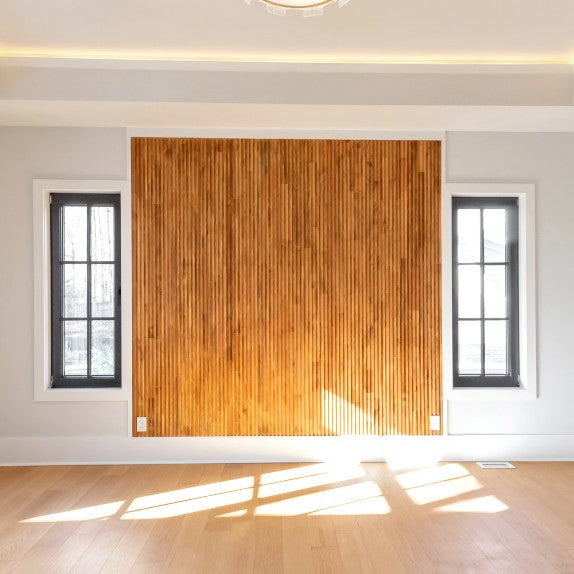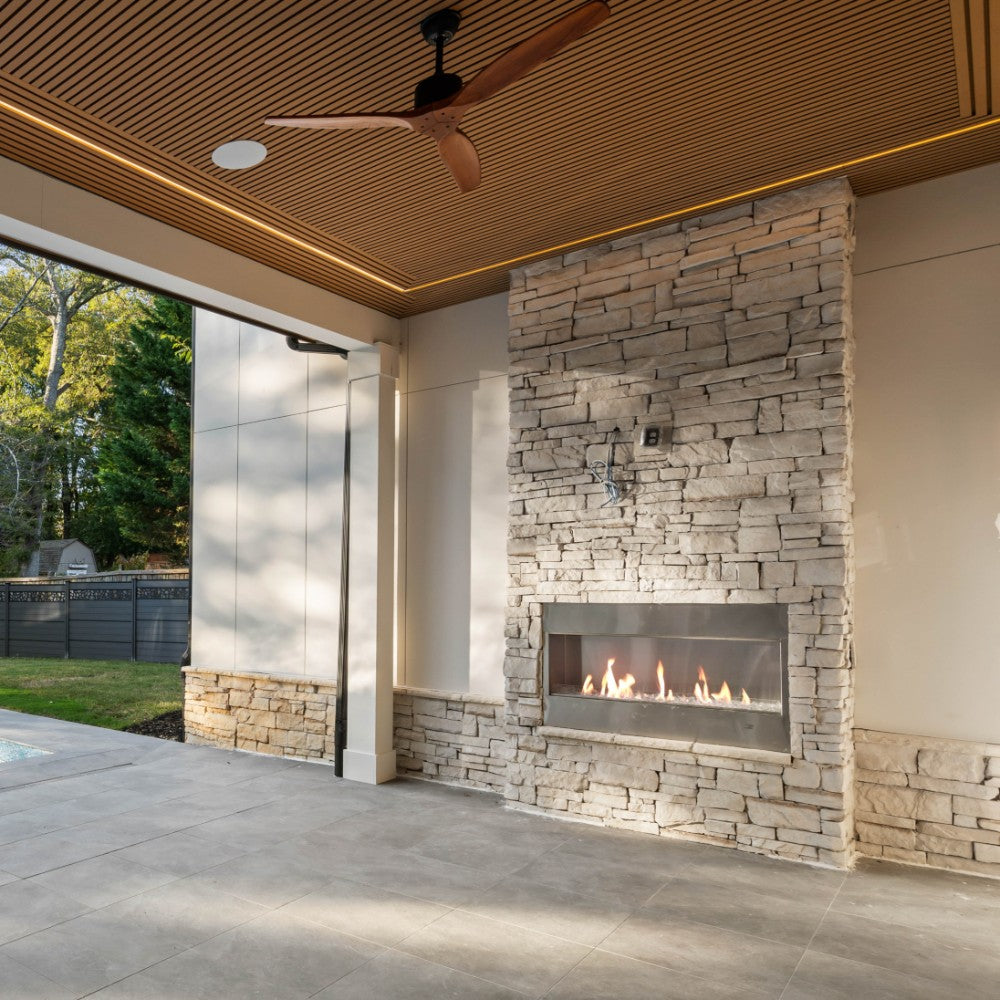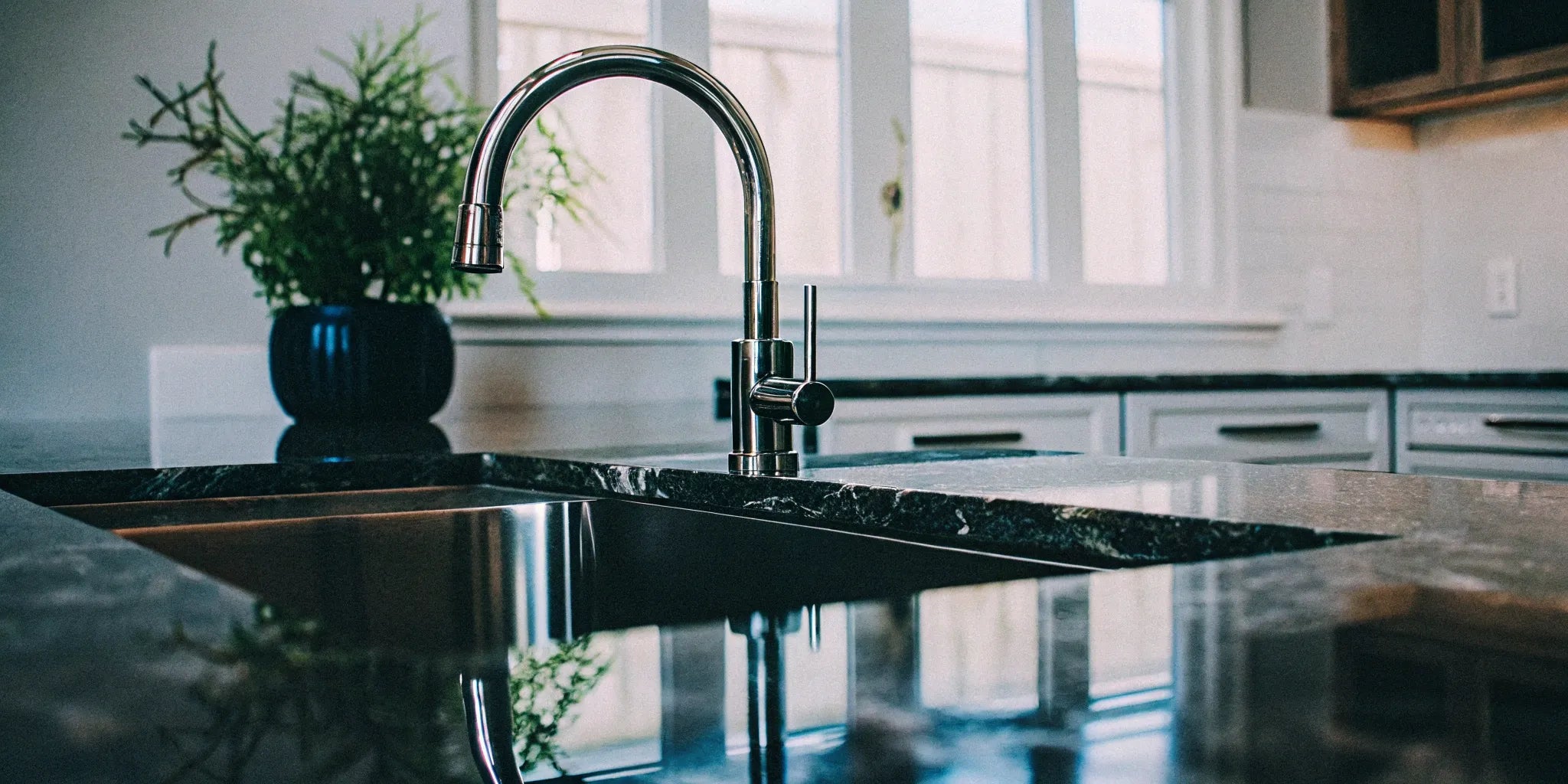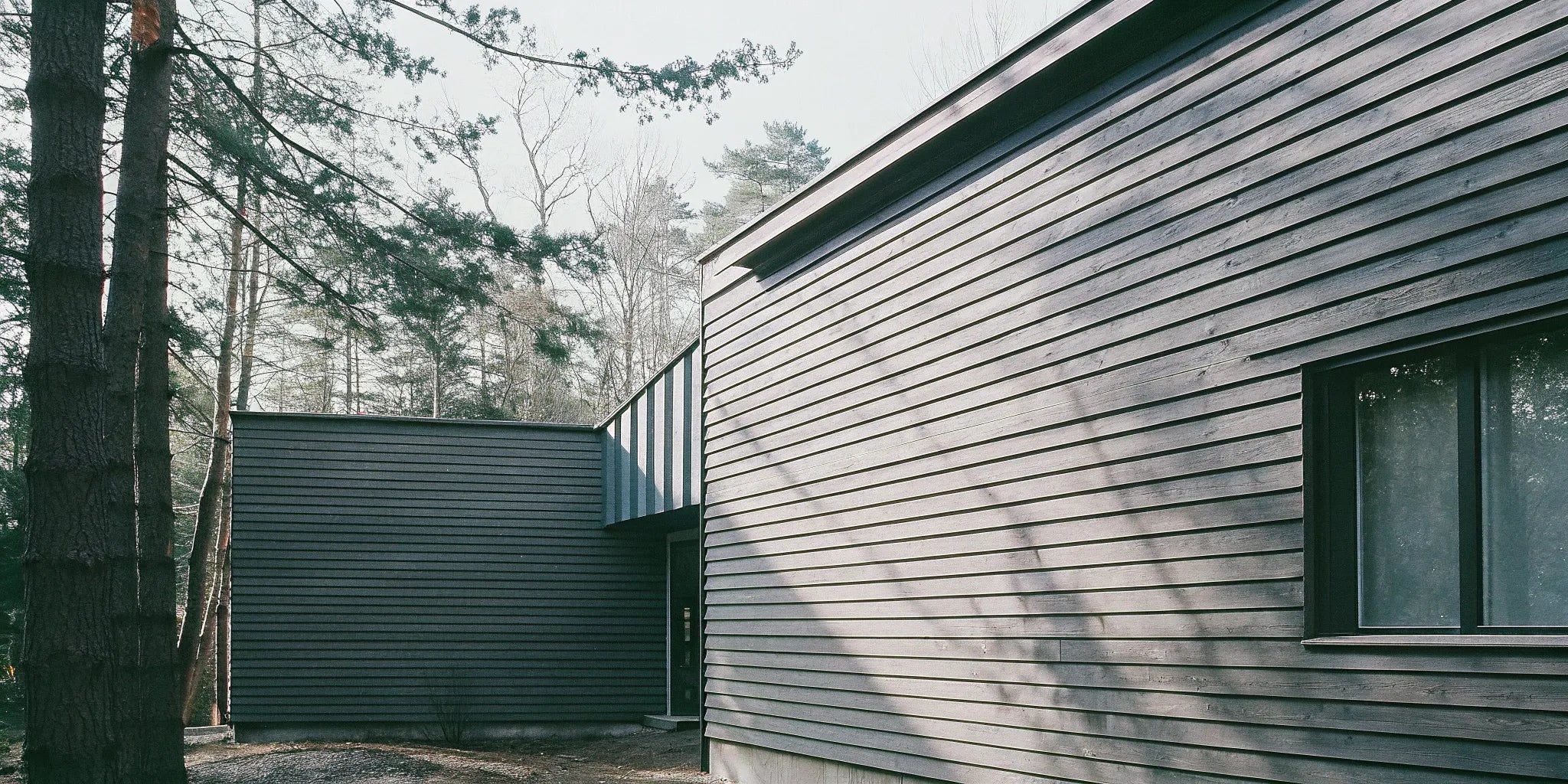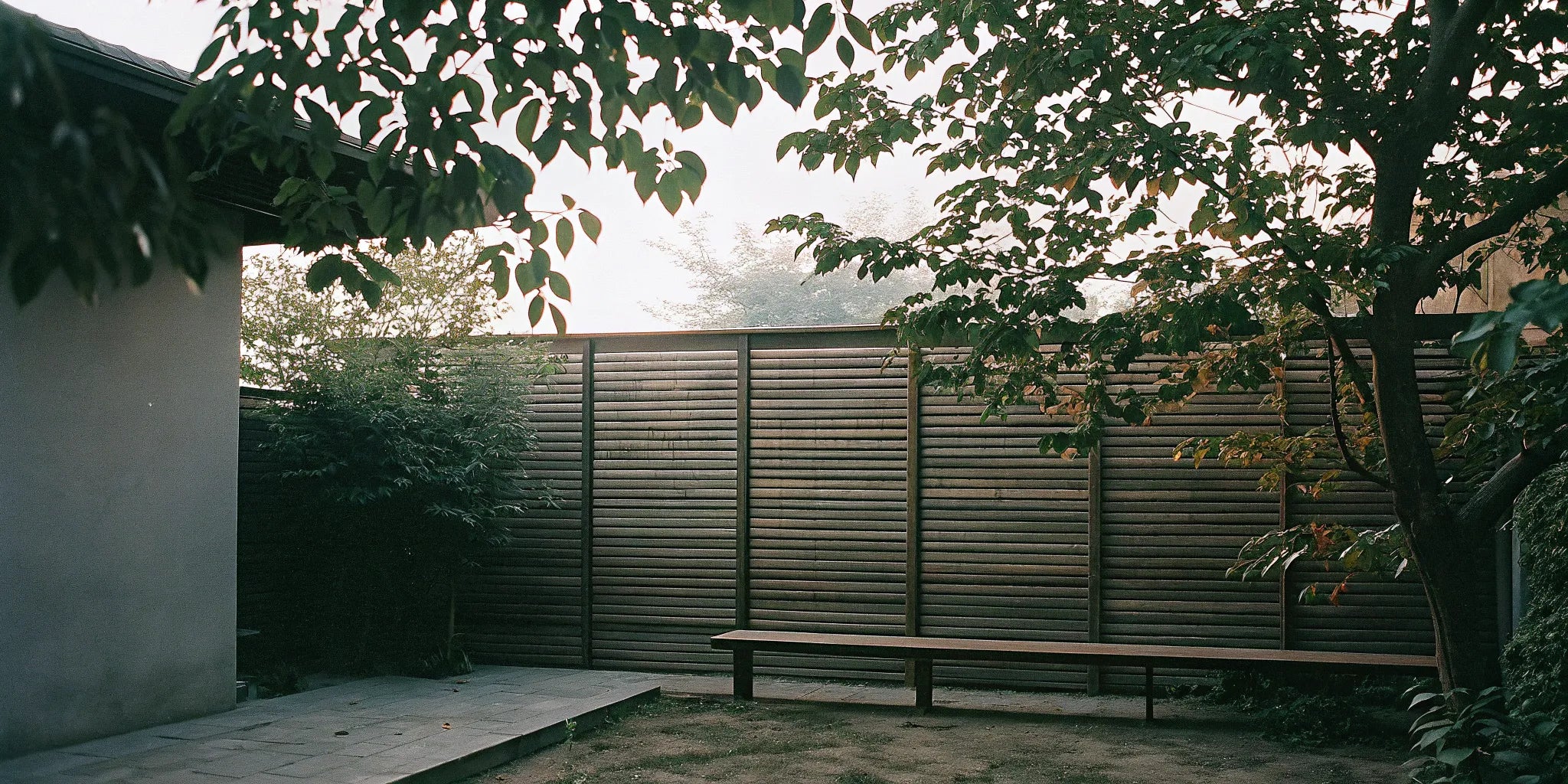
Wood Slat Wall Panel Outdoor: The Ultimate Guide
A great outdoor space is both beautiful and functional, offering a private retreat to relax and entertain. But what if your patio feels a little too exposed, or you have an unsightly AC unit that ruins the view? A well-placed wood slat wall panel outdoor feature is the perfect solution. These panels are a designer's secret weapon for solving common backyard problems in a stylish way. They can create elegant privacy screens that don't feel confining, hide clutter, and even help dampen ambient noise. Ahead, we’ll cover practical design ideas that show you how to use these versatile panels to add function and sophisticated style to your outdoor areas.
Key Takeaways
- Balance Aesthetics with Maintenance: Decide between the classic look of natural wood, which needs regular sealing, and the long-lasting, low-effort durability of composite materials like WPC.
- Focus on Quality and Proper Installation: Ensure longevity by selecting panels with UV resistance and a strong warranty. Proper installation with a ventilation gap is non-negotiable for preventing moisture damage.
- Get Creative with Functional Design: Use slat panels to do more than cover a wall. They are perfect for creating stylish privacy screens, designing a stunning accent wall, or hiding unsightly utility units.
What Are Outdoor Wood Slat Panels?
If you're looking to add a modern touch to your home's exterior, outdoor wood slat panels are a fantastic choice. These versatile architectural elements bring a sense of rhythm and warmth to any outdoor space, from patios and entryways to entire building facades. They consist of linear slats, usually made from wood or a composite material, that create a clean, textured look. More than just a decorative finish, these wall panels can define spaces, add privacy, and introduce a layer of sophisticated design. When thoughtfully layered with other materials like stone, stucco, or metal, they create a visually striking environment that feels both contemporary and inviting.
Common Types of Outdoor Panels
When you start shopping for outdoor panels, you'll find a few common material types. Natural woods like cedar and redwood are popular for their inherent beauty and resistance to the elements, but they do require regular maintenance to keep them looking their best. For a more hands-off approach, many homeowners and builders are turning to composite options. Exterior Fluted Slat Wall Panels made from Wood Polymer Composite (WPC) are a great example. They deliver the warm, rich look of wood without the risk of rot, warping, or insect damage, making them a durable and practical choice for any climate.
Essential Design Features
Beyond aesthetics, the best outdoor slat panels are engineered for performance. Look for panels specifically designed to withstand sun, rain, and temperature changes without fading or degrading. High-quality options are built to be strong and long-lasting, requiring very little upkeep over the years. Many modern composite panels are also an eco-friendly choice, as they are often made from recycled materials and don't contain the harmful chemicals sometimes used to treat natural wood. This means you can get a beautiful, durable exterior finish that’s also kinder to the environment.
Why Add Wood Slat Panels to Your Outdoor Space?
Outdoor wood slat panels are more than just a design trend; they're a practical way to add character, function, and value to your home's exterior. Whether you want to create a stunning accent wall on your patio, build a private oasis in your backyard, or simply cover up a less-than-perfect surface, these panels offer a versatile solution. They blend the natural warmth of wood with modern engineering, giving you a finish that is both beautiful and built to last.
Durability and Weather Resistance
When you're choosing materials for the outdoors, durability is non-negotiable. You need something that can handle sun, rain, and temperature changes without warping, fading, or falling apart. This is where modern Exterior Fluted Slat Wall Panels truly shine. Many are made from Wood Polymer Composite (WPC), a material specifically engineered to withstand the elements. Unlike traditional wood, which requires regular sealing and maintenance to prevent rot and decay, WPC offers the look of wood with far less upkeep. This means you get a beautiful, long-lasting feature without committing to years of maintenance.
Style and Versatility
Exterior slat panels are a designer's dream because they bring instant texture, rhythm, and warmth to any surface. They can transform a plain stucco wall into a sophisticated focal point or add a contemporary touch to a traditional brick exterior. The clean, linear design works well with a variety of architectural styles. You can install them vertically to make a space feel taller or horizontally to create a sense of width. They also pair beautifully with other materials like stone, concrete, and metal, allowing you to create a layered look that feels custom and intentional.
Privacy and Sound Control
A well-placed slat wall can solve some of the most common backyard problems. If your patio feels a little too exposed to the neighbors, a vertical slat wall can act as a stylish privacy screen without completely blocking light and air. It’s also a brilliant way to hide unsightly necessities like air conditioning units, pool pumps, or trash bins. Beyond visual privacy, these panels can also help with sound control. The slatted structure helps to break up and absorb sound waves, which can dampen ambient noise and make your outdoor living area a more peaceful and relaxing retreat.
Choosing the Right Material for Outdoor Panels
Picking the right material for your outdoor slat panels is a big decision. It’s about more than just looks—it’s about finding a solution that can handle whatever your local climate throws at it, from scorching sun to heavy rain. The material you choose will directly impact how much time you spend on maintenance, how long your panels last, and the overall vibe of your outdoor space. Think of it as the foundation of your project. Do you love the timeless, authentic look of real wood and don't mind a bit of upkeep? Or are you looking for a set-it-and-forget-it option that combines modern engineering with classic style?
There’s no single "best" material; it all comes down to your priorities. We’ll walk through the most popular options, from traditional woods like cedar and teak to innovative composites that offer incredible durability. Understanding the pros and cons of each will help you make a confident choice that fits your home’s aesthetic, your budget, and your lifestyle. Some materials offer unparalleled natural beauty, while others provide a level of weather resistance that makes them practically maintenance-free. Let's explore the key players so you can find the perfect match for your exterior wall project and create an outdoor area you'll love for years to come.
Natural Wood (Cedar, Redwood, Teak)
There’s something undeniably beautiful about natural wood. Materials like cedar, redwood, and teak are popular for a reason—they bring warmth and a classic, organic feel to any exterior. These woods have natural oils and tannins that make them inherently resistant to decay and insects, giving them a head start against the elements. Cedar is known for its lovely aroma and durability, while redwood offers a rich, deep color that stands out. Teak is a powerhouse, prized for its incredible strength and water resistance. The main trade-off? Natural wood requires regular maintenance, like sealing or staining, to protect it from UV rays and moisture and keep it looking its best.
Wood Plastic Composites (WPC)
If you love the look of wood but not the upkeep, Wood Plastic Composites (WPC) are a fantastic alternative. WPC is an engineered material made by blending wood fibers with recycled plastics. The result is a panel that beautifully mimics the texture and appearance of natural wood while offering superior durability. These panels are specifically designed to stand up to outdoor conditions, so you don't have to worry about them fading, warping, or splintering. Our Exterior WPC Fluted Slat Wall Panels are a great example, providing a low-maintenance solution that keeps its good looks season after season without needing to be sealed or stained.
Other Composite Options
Beyond WPC, the world of composite materials offers even more choices for your outdoor project. You can find panels made from various blends that are engineered for specific benefits, like enhanced UV protection or a particular wood-grain finish. For example, some composite slat panels are designed to be completely waterproof, making them ideal for poolside cabanas or homes in rainy climates. These advanced materials give you the aesthetic of natural materials without the vulnerability to weather. Exploring the full range of exterior wall panels can reveal innovative options that perfectly match your design vision and performance needs, giving you peace of mind and a beautiful finish.
How the Materials Stack Up
So, how do you choose? It really boils down to balancing aesthetics, durability, and maintenance. Natural wood offers an authentic, high-end look that is hard to replicate, but it comes with a commitment to regular care. On the other hand, composite materials like WPC provide a highly durable, low-maintenance alternative that holds up beautifully against the elements. While composites might have a higher initial cost, they can save you time and money on upkeep in the long run. Consider what matters most to you: the timeless appeal of real wood or the practical, long-lasting performance of an engineered composite.
Comparing Outdoor Slat Panel Brands
Once you’ve decided on the right material for your project, the next step is to explore different brands. The market for outdoor slat panels has grown, giving you plenty of great options to fit your specific style and budget. Each brand offers a unique combination of materials, finishes, and installation systems. Looking at a few key players can help you understand what’s available and find the perfect match for your home’s exterior. From premium composite solutions to stunning natural wood looks, there’s a panel out there that will bring your vision to life.
A Look at USA Builders Depot's Exterior Panels
At USA Builders Depot, we focus on providing high-quality, durable solutions that look incredible. Our Exterior Fluted Slat Wall Panels are designed to deliver a modern, sophisticated aesthetic while standing up to the elements. Made from robust composite materials, these panels resist moisture, fading, and pests, ensuring your outdoor space looks fantastic for years with minimal upkeep. They are perfect for creating a stylish accent wall on a patio, updating a home’s facade, or building a chic privacy screen. The clean lines and rich textures make any garden or outdoor living area feel more special and thoughtfully designed.
Other Brands to Consider
Beyond our own collection, a few other brands are making waves in the exterior panel market. Woody Walls is known for its premium panels that create a clean, contemporary look, offering a variety of wood-look slat styles for different outdoor applications. Their products are a popular choice for homeowners aiming for a sleek, modern finish. Another great option is WoodPlank, which specializes in composite cladding made from 100% recycled materials. This makes them an excellent choice if sustainability is a top priority for your project. Their commitment to eco-friendly manufacturing provides a guilt-free way to enhance your home’s exterior without compromising on style or performance.
Balancing Price and Quality
When you’re shopping for outdoor slat panels, it’s all about finding the right balance between cost and quality. While it can be tempting to go for the lowest price, investing in a more durable, high-quality panel system often pays off with better longevity and less maintenance. The cost for exterior panels typically ranges from $6 to $30 per square foot, depending on the material and brand. Remember to budget for more than just the panels themselves—factor in costs for trim, fasteners, and potential installation labor. For contractors and designers, signing up for a trade program can provide access to bulk pricing and discounts, making it easier to get premium materials while staying on budget.
What to Look For in a Quality Outdoor Panel
When you’re ready to invest in outdoor slat panels, it’s important to know that not all products are created equal. The last thing you want is a beautiful new accent wall that starts to warp, fade, or fall apart after a few seasons. To make sure your project stands the test of time, focus on a few key indicators of quality. These features separate the premium panels from the rest and ensure you get the best return on your investment in terms of both durability and style.
Weather Resistance Ratings
Your exterior panels will be exposed to everything from harsh sun and heavy rain to humidity and temperature swings. That’s why weather resistance is non-negotiable. Look for panels made from materials specifically engineered for the outdoors, like Wood Plastic Composites (WPC). These materials are designed to resist moisture, preventing the rot, swelling, and warping that can plague natural wood if it’s not meticulously maintained. High-quality exterior fluted slat wall panels are built to handle diverse climates, ensuring they remain stable and structurally sound for years. Checking for a strong weather resistance rating is the first step toward a long-lasting installation.
UV and Fade Resistance
The sun’s ultraviolet rays can be incredibly damaging, causing colors to fade and materials to become brittle over time. To keep your panels looking vibrant, prioritize products with built-in UV and fade resistance. Many composite panels are manufactured with protective layers or UV-inhibiting pigments that shield them from sun damage. This feature is especially critical for darker-colored panels, which absorb more sunlight and are more prone to fading. Choosing a UV-resistant product means your outdoor space will maintain its intended aesthetic without looking washed out after a few summers. It’s a key feature for protecting your home’s curb appeal and your investment in beautiful exterior shiplap cladding.
Warranty and Protection
A manufacturer’s warranty is a powerful indicator of their confidence in a product. A comprehensive warranty provides peace of mind and protects you from potential defects or premature wear. When comparing panels, don’t just look at the length of the warranty—read the fine print to see what it covers. The best warranties go beyond basic manufacturing defects to include protection against things like significant color fading, staining, and structural damage from mildew. A company that stands behind its products with a solid warranty is one you can trust. You can often get a sense of product quality by reading customer reviews and seeing how their materials have performed in real-world projects.
A User-Friendly Installation System
Whether you’re a seasoned contractor or a dedicated DIYer, the installation system matters. A complicated process can add time, frustration, and cost to your project. Look for panels that feature a user-friendly design, such as a tongue-and-groove system. This allows the panels to interlock securely and simplifies alignment, creating a clean, seamless finish. Systems that install with standard screws are also a plus, as they don’t require specialized tools. An intuitive installation process makes the project more accessible for homeowners and helps professionals complete jobs more efficiently. Exploring different wall panels will give you a better idea of the installation methods available.
How to Install Outdoor Wood Slat Panels
Installing outdoor wood slat panels can transform your home’s exterior, and the process is more straightforward than you might think. Whether you’re a seasoned DIYer or prefer to hire a professional, a successful installation starts with a solid plan. Modern panel systems are often designed for user-friendly assembly, but following the correct steps is key to a beautiful and long-lasting finish.
Planning and Preparation
Before you begin, take the time to plan your project thoroughly. Start by measuring the installation area to determine how many panels you’ll need. It’s always a good idea to order a little extra to account for any cuts or mistakes. Next, gather your tools. You’ll typically need a measuring tape, a level, a saw for cutting panels to size, a drill, and the appropriate screws for your wall type.
Most importantly, read the manufacturer’s installation guide for your specific panels. Every system is slightly different, and the instructions will provide crucial details on spacing, fasteners, and finishing touches. This simple step can save you from major headaches down the road.
Step-by-Step DIY Installation
If you’re comfortable with basic carpentry, you can likely install wood slat panels yourself. Many modern systems, including Exterior Fluted Slat Wall Panels, use an interlocking or tongue-and-groove design that simplifies the process. After preparing your wall surface, you’ll typically install vertical battens to mount the panels on. This creates an essential air gap for ventilation.
Start by attaching your first panel, making sure it’s perfectly level—this will guide the rest of your installation. Continue adding panels, locking them into place and securing them with screws according to the instructions. Taking your time to ensure each panel is snug and aligned will result in a clean, professional look that you can be proud of.
When to Call a Professional
There’s no shame in calling for backup. If you’re short on time, don’t have the right tools, or simply feel the project is outside your comfort zone, hiring a professional is a smart move. A contractor will ensure the panels are installed securely, correctly, and in compliance with any local building codes. This is especially important for large-scale projects or installations on upper floors.
Investing in a professional can save you from costly errors and give you peace of mind that the job is done right. For contractors and designers, partnering with a reliable supplier is key. Trade professionals can apply for an account to get access to bulk pricing and specialized support for their projects.
Ensuring Proper Ventilation
Proper ventilation is one of the most critical aspects of installing any exterior cladding. When you install wood slat panels, you should create a small air gap between the panels and your home’s weather-resistant barrier. This is usually done by mounting the panels on vertical wood battens or a specialized furring system.
This gap allows air to circulate behind the panels, which helps moisture evaporate and keeps your wall assembly dry. Without proper airflow, trapped water can lead to rot, mold, and other structural issues over time. Don’t skip this step—it’s essential for protecting your home and ensuring your new siding lasts for decades.
How to Maintain Your Outdoor Panels
One of the best things about modern outdoor slat panels is how little upkeep they require. Whether you choose natural wood or a composite material, you’ve selected a durable finish for your home’s exterior. However, a little routine care will go a long way in preserving that fresh, just-installed look for years to come. The right maintenance plan keeps your panels looking vibrant and helps protect your investment against the elements.
Think of it as a simple seasonal check-up. By spending just a little time cleaning and inspecting your panels, you can prevent minor issues from becoming bigger problems. The specific steps will vary slightly depending on your material choice—natural wood needs a bit more attention than composites—but the overall process is straightforward and manageable for any homeowner. Let’s walk through the key steps to keeping your outdoor slat walls in prime condition.
Regular Cleaning and Care
Keeping your panels clean is the easiest way to maintain their beauty. Over time, dust, pollen, and grime can build up on the surface. For most exterior fluted slat wall panels, a gentle rinse is all you need. You can often clean them with a pressure washer on a low setting to remove any buildup without damaging the finish. If you encounter more stubborn spots, a soft-bristle brush with a simple solution of mild soap and water will do the trick. Plan to give your panels a quick wash once or twice a year, or as needed, to keep them looking sharp.
Sealing and Protective Treatments
If you’ve opted for natural wood panels, applying a protective sealant is the most important maintenance step. Wood is a beautiful and durable material, but it needs to be properly protected from moisture and UV rays to prevent warping, cracking, or fading. A quality exterior wood sealant creates a barrier against the elements. You should plan to reapply the sealant every two to three years, though your local climate might require a different schedule. For example, areas with intense sun or heavy rainfall may need more frequent applications. This step is where composite panels have an edge, as they are manufactured for weather resistance and don’t require sealing.
Seasonal Maintenance Checklist
A simple seasonal checklist can help you stay on top of panel maintenance. In the spring, give your panels a good cleaning to wash away winter grime and inspect them for any signs of wear. It’s the perfect time to check if the finish is still repelling water or if it’s time for a new coat of sealant. In the fall, clear away any fallen leaves or debris that could trap moisture against the panels. Before winter arrives, do a final check to ensure all panels and fasteners are secure. This kind of proactive home maintenance ensures your slat walls are ready for whatever the weather brings.
Design Ideas for Outdoor Slat Panels
Exterior slat panels are incredibly versatile, offering a canvas for your creativity. Whether you’re aiming for a subtle architectural detail or a bold statement piece, these panels can transform any outdoor area. They add warmth, texture, and modern lines that work with almost any style. Here are a few ideas to get you started on designing your perfect outdoor space.
Mixing Materials
Exterior slat wood panels bring a sense of rhythm and warmth to outdoor spaces, and they shine when layered thoughtfully with other materials. Don’t be afraid to create contrast. The clean, linear pattern of Exterior Fluted Slat Wall Panels looks stunning against the rugged texture of a stone veneer wall or the smooth, industrial feel of poured concrete. You can also pair them with stucco for a classic-meets-modern look or use them alongside metal accents for a sleek, contemporary finish. This interplay of textures adds depth and visual interest, making your home’s exterior feel custom and thoughtfully designed.
Creating Texture with Accent Walls
One of the most popular ways to use outdoor panels is to create a stunning accent wall. This is a fantastic way to establish a focal point for a patio, deck, or even your home’s main entrance. Imagine a beautiful wood slat wall as the backdrop for your outdoor kitchen, a cozy seating area, or a collection of vibrant potted plants. The vertical or horizontal lines draw the eye and add a layer of texture that breaks up flat, uninspired surfaces. You can use durable composite panels that fit any style and require minimal maintenance, giving you a high-impact look that lasts.
Functional Uses: Privacy Screens and Dividers
Beyond their good looks, slat walls are incredibly practical. A vertical wood slat wall is the perfect way to add privacy to your patio without making it feel boxed in. The gaps between the slats allow light and air to filter through, maintaining an open and breezy atmosphere while shielding you from neighbors. You can also use them to hide less attractive features, like an AC unit, pool pump, or trash bins. Slat panels work beautifully as space dividers, helping you define different zones in a larger backyard—separating a dining area from a lounge space, for example.
Choosing Colors and Finishes
The color and finish of your slat panels play a huge role in the final look. Lighter options, like white oak, bring a natural warmth to your outdoor areas and are perfect for creating an inviting, airy feel on decks or patios. For a more dramatic and modern statement, consider a darker stain or a charcoal-colored composite panel. If you want complete control, you can opt for Paint and Stain Grade Panels that allow you to match your home’s existing trim or introduce a bold, contrasting color. Think about how the finish will complement your home’s siding, landscaping, and outdoor furniture to create a cohesive design.
Common Questions About Outdoor Panels
When you're planning an exterior project, it's natural to have a few questions. Outdoor slat panels are a fantastic investment, but you want to be sure you're making the right choice for your climate, budget, and design goals. Let's walk through some of the most common questions we hear about moisture, sustainability, and what it takes to properly support these beautiful panels. Getting these details right from the start ensures your project is a success from day one and for many years to come.
Moisture and Installation Tips
One of the biggest concerns for any outdoor material is moisture. The great news is that exterior fluted slat wall panels are designed to withstand the elements. Materials like cedar and redwood have natural resistance to rot and insects. For even lower maintenance, wood-plastic composites (WPC) offer incredible durability without the need for regular sealing. Regardless of the material, proper installation is key to preventing moisture issues. Ensuring there's adequate ventilation behind the panels and following the manufacturer's guidelines will help your slat wall look great for years. Most panels are also simple to clean with just mild soap and water when needed.
Sustainability and Environmental Impact
It feels good to know your design choices are also good for the planet. Many modern outdoor panels are an excellent sustainable option. Wood-plastic composite (WPC) panels, in particular, often lead the way in eco-friendly design. They are frequently made from a blend of recycled plastics and wood fibers, which diverts waste from landfills. This process creates a highly durable product that resists rot and decay, extending its lifespan and reducing the need for replacements. By choosing a long-lasting, low-maintenance material made from recycled content, you’re making a responsible choice for your home and the environment.
Weight and Support Requirements
While slat panels are strong, they aren't designed to bear heavy structural loads. It's important to understand their weight limitations to ensure a safe and lasting installation. Before you begin, always check the manufacturer's specifications for the panel's weight and recommended support structure. In most cases, you'll need to install the panels onto a sturdy frame of wood or aluminum joists rather than directly onto the siding. This framework provides the necessary support and ensures the panels remain secure over time. For large-scale projects, our trade professionals often build out a subframe to guarantee the wall can handle the panels perfectly.
Related Articles
- Slat Wall Panel Guide: Everything You Need to Know
- Wood Slat Panel: The Ultimate Buyer's Guide
- Exterior Fluted Slat Wall Panel, Ash Gray | USA Builders Depot


